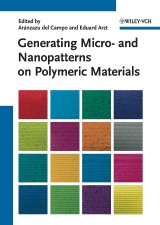Details

Generating Micro- and Nanopatterns on Polymeric Materials
2. Aufl.
|
174,99 € |
|
| Publisher: | Wiley-VCH |
| Format | EPUB |
| Published: | 08.04.2011 |
| ISBN/EAN: | 9783527633463 |
| Language: | englisch |
| Number of pages: | 390 |
DRM-protected eBook; you will need Adobe Digital Editions and an Adobe ID to read it.
Descriptions
New micro and nanopatterning technologies have been developed in the last years as less costly and more flexible alternatives to phtolithograpic processing. These technologies have not only impacted on recent developments in microelectronics, but also in emerging fields such as disposable biosensors, scaffolds for tissue engineering, non-biofouling coatings, high adherence devices, or photonic structures for the visible spectrum. This handbook presents the current processing methods suitable for the fabrication of micro- and nanostructured surfaces made out of polymeric materials. It covers the steps and materials involved, the resulting structures, and is rounded off by a part on applications. As a result, chemists, material scientists, and physicists gain a critical understanding of this topic at an early stage of its development.
Preface<br> <br> PART I: Molding<br> <br> MATERIALS AND PROCESSES IN UV-ASSISTED NANOIMPRINT LITHOGRAPHY<br> Introduction<br> UV-Assisted Nanoimprint Lithography<br> Imprinting Materials<br> Mold Fabrication and Anti-Sticking Strategies<br> Conclusion<br> ROLL-TO-ROLL NANOIMPRINT LITHOGRAPHY AND DYNAMIC NANO-INSCRIPTION<br> Introduction<br> Roll-to-Roll Nanoimprint Lithography<br> Dynamic Nano-Inscription<br> Summary<br> SOLVENT-ASSISTED MOLDING<br> The Principle of Solvent-Assisted Molding<br> Solvent-Assisted Molding with a Good Solvent<br> Solvent-Assisted Molding with a Poor Solvent<br> Other Techniques<br> Applications of Solvent-Assisted Molding<br> Conclusions<br> SOFT LITHOGRAPHY AND VARIANTS<br> Introduction<br> Key Features of Soft Lithography<br> Microcontact Printing of Self-Assembled Monolayers<br> Soft Molding Techniques<br> Summary<br> <br> PART II: Writing and Printing<br> <br> TRANSFER PRINTING PROCESSES<br> Introduction<br> Techniques<br> Key Issues in Transfer Printing Methods<br> Advantages and Disadvantages<br> Applications<br> DIRECT-WRITE ASSEMBLY OF 3D POLYMERIC STRUCTURES<br> Introduction<br> Polyelectrolyte Inks<br> Silk Fibroin Inks<br> Hydrogel Inks<br> Opportunities and Challenges<br> <br> PART III: Laser Scanning<br> <br> THREE-DIMENSIONAL MICROFABRICATION BY TWO-PHOTON POLYMERIZATION<br> Introduction<br> Fundamentals<br> Materials<br> Experimental Setup<br> Resolution<br> Microstructures: Properties and Characterization<br> Applications<br> Limitations and Future Directions<br> LASER MICROMACHINING OF POLYMERS<br> Introduction<br> Principles of Beam-Matter Interaction in Ablation Processes<br> Laser Ablation of Polymers<br> Laser-Induced Roughening<br> Generative Laser Processes<br> Conclusion<br> <br> PART IV: Self Organization<br> <br> COLLODAL POLYMER PATTERNING<br> Introduction<br> Emulsion Polymerization<br> Forces and Mechanisms in Polymer Dispersion<br> Polymer Patterns from Colloidal Suspensions<br> Summary and Outlook<br> DIRECTED SELF-ASSEMBLY OF BLOCK COPOLYMER FILMS<br> Introduction<br> Energetics of the Basic Directed Assembly System<br> Examples of Directed Assembly<br> Conclusion<br> SURFACE INSTABILITY AND PATTERN FORMATION IN THIN POLYMER FILMS<br> Introduction<br> Origin of Surface Instability<br> Polymer Thin Film Dewetting<br> Dewetting on Patterned Substrates<br> Instability due to Externally Imposed Fields<br> Conclusion<br> <br> PART V: Applications<br> <br> CELLS ON PATTERNS<br> Introduction<br> Physicochemical Properties of the Substrate Read by Cells<br> Conclusions<br> POLYMER PATTERNS AND SCAFFOLDS FOR BIOMEDICAL APPLICATIONS AND TISSUE ENGINEERING<br> Introduction<br> Cell Response to 2D Patterns<br> Cells onto 3D Objects and Scaffolds<br> Concluding Remarks<br> NANO- AND MICRO-STRUCTURED POLYMER SURFACES FOR THE CONTROL OF MARINE BIOFOULING<br> Introduction<br> Replica Molding in PDMS and Other Polymers<br> Stretched Topographies in PDMS<br> Structured Surfaces by Self-Assembly<br> Nanocomposites<br> Nanostructured Polymer Surfaces by Vapor Deposition Methods<br> Conclusions<br> BIOINSPIRED PATTERNED ADHESIVES<br> Introduction<br> Vertical Structures<br> Tilted Structures<br> Coated Structures<br> Hierarchical Structures<br> 3D Structures<br> Switchable Adhesion<br> Outlook<br> PATTERNED MATERIALS AND SURFACES FOR OPTICAL APPLICATIONS<br> Introduction<br> Optical Micro- and Nanostructures for Applications<br> Conclusion<br>
Aranzazu del Campo is Minerva Fellow at the Max-Planck-Institut fur Polymerforschung (Mainz, Germany) and heads the independent research group "Active Surfaces and Materials". She received her PhD in Chemistry from the Instituto de Ciencia y Tecnologia de Polimeros (Madrid, Spain) in 2000. She then joined the Max-Planck-Institut fur Polymerforschung as Marie Curie Fellow to work in the field of surface chemistry and nanotechnology. After a short stay at the Universita degli Studi di Urbino (Italy), she became Research Group Leader at the Max-Planck-Institut fur Metallforschung in 2005 (Stuttgart, Germany) and at the Leibniz Institute for New Materials (Saarbrucken, Germany) in 2008.<br> <br> Eduard Arzt is Scientific Director and Chairman at INM - Leibniz Institute for New Materials in Saarbrucken and holds the Chair for New Materials at Saarland University. He obtained his PhD in Physics and Mathematics from the University of Vienna, Austria, in 1980. After a postdoctoral stay at the University of Cambridge, he led a research group at the Max Planck Institute for Metals Research in Stuttgart. From 1990 to 2007, he was a Director at the Max Planck Institute for Metals Research, Stuttgart, and Professor for Metal Physics at the University of Stuttgart. He has been Visiting Professor at Stanford University and Massachusetts Institute of Technology and maintains strong links to the international materials community.
New micro and nanopatterning technologies have been developed in the last years as less costly and more flexible alternatives to phtolithograpic processing. These technologies have not only impacted on recent developments in microelectronics, but also in emerging fields such as disposable biosensors, scaffolds for tissue engineering, non-biofouling coatings, high adherence devices, or photonic structures for the visible spectrum. This handbook presents the current processing methods suitable for the fabrication of micro- and nanostructured surfaces made out of polymeric materials. It covers the steps and materials involved, the resulting structures, and is rounded off by a part on applications. As a result, chemists, material scientists, and physicists gain a critical understanding of this topic at an early stage of its development.

















